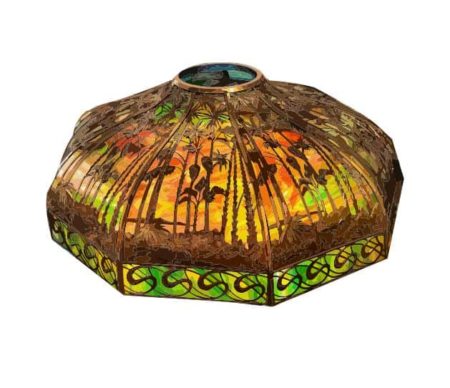Stained Glass or Art-Glass lampshades are jewelry for your home but they are fragile and easily broken
At Artistry in Glass, we have been restoring broken stained glass lampshades since 1986 and so we know all about repairing glass lampshades.
Most stained glass lampshades can be repaired but the cost varies dramatically depending on the type of shade and the severity of the damage.
Read this post to learn about the main categories of art glass shades and the techniques required to repair them.
The six types of lampshades most often repaired by Artistry in Glass
- Tiffany-style shades made using the “copper-foil” method.
- Leaded glass shades made with lead or zinc came.
- Slag glass lamps made with opalescent (semi-opaque) slag glass.
- Beveled glass lampshades and fixtures.
- Porch lampshades and lanterns.
- Opal, ball or dome shades – Victorian or reproduction.
1) Tiffany-Style Lampshades
Louis Comfort Tiffany (1848 – 1933) was a US artist and designer who worked in decorative arts and is best known for his stained glass. He is the American artist most identified with the Aesthetic and Art Nouveau movements. Tiffany designed stained glass windows and lamps, glass mosaics, blown glass, ceramics, jewelry, enamels, and metalwork. He was the founding Design Director at his family company, Tiffany & Co.
Entrepreneurial Breakthroughs
The two crucial innovations which allowed Tiffany to revolutionize stained-glass lamp design were the manufacture of opalescent glass and the development of the copper-foil method of manufacture.
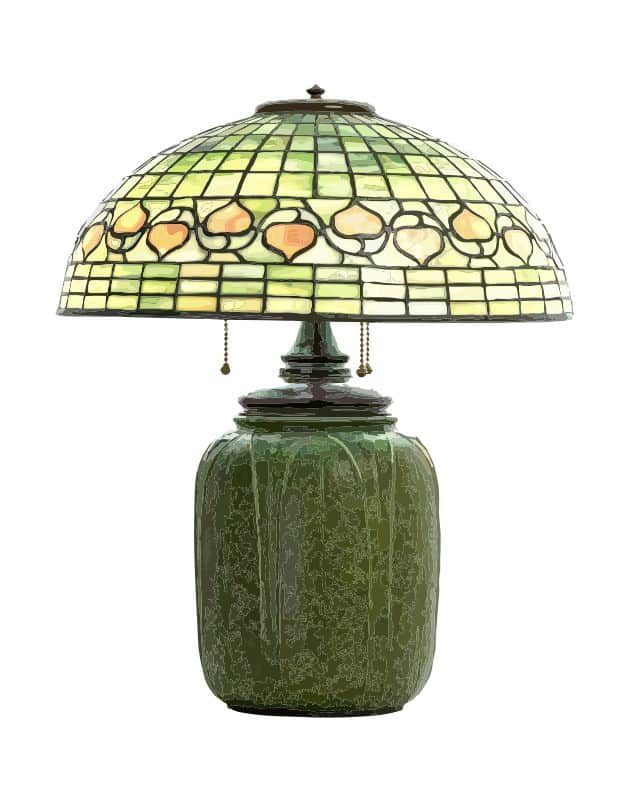
Opalescent Glass
In the early to mid-1800s, American designers were frustrated by the limited availability of colored glass – European manufacturers sent their second-best glass to the US. In response to this, John La Farge, and later Tiffany developed semi-opaque “opalescent” glass which could be made in multicolored textures simulating, sunsets, lakes, flowers, leaves and other features of nature. To give himself control of production he hired the famous English glassmaker Arthur Nash and helped him establish the Stourbridge glass factory in 1893, in Corona, N.Y. The availability of unique art glass enabled Tiffany to design astonishing landscape masterpieces like the “River of Life” window (right/below) as well as iconic stained-glass lampshades.
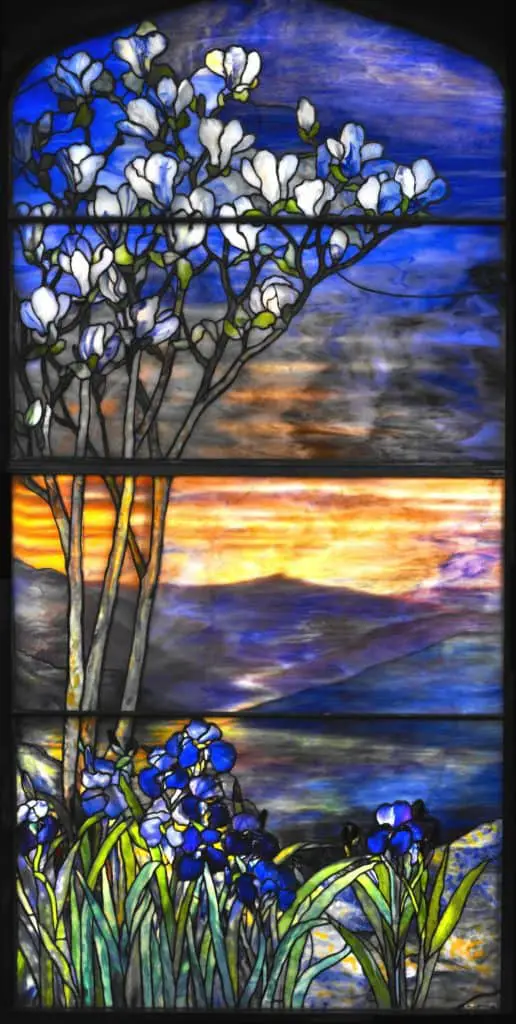
Driehaus Museum.
The Copper-Foil Method
In a brilliant and perceptive business move, Tiffany acquired Stanford Bray’s patent (https://patents.google.com/patent/US349424A/en) for the “copper foil” technique, which, by edging each piece of cut glass in copper foil and soldering the whole together to create his windows and lamps, made possible a level of detail previously unknown.
Copper-foiled construction contrasts with the traditional method of painting on colorless glass and then installing the painted or stained glass in lead came (channel) – the traditional fabrication method for centuries in Europe.
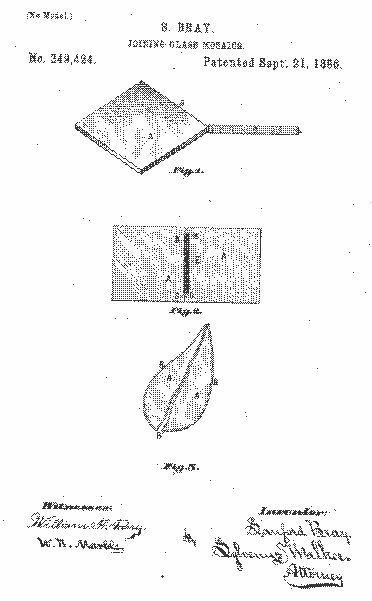
The availability of opalescent art glass and the unique copper-foil manufacturing method allowed Tiffany, in 1895, to start making beautifully complex lampshades following natural, or botanical designs using flowers, dragonflies, spiders with webs, butterflies, and peacock feathers.
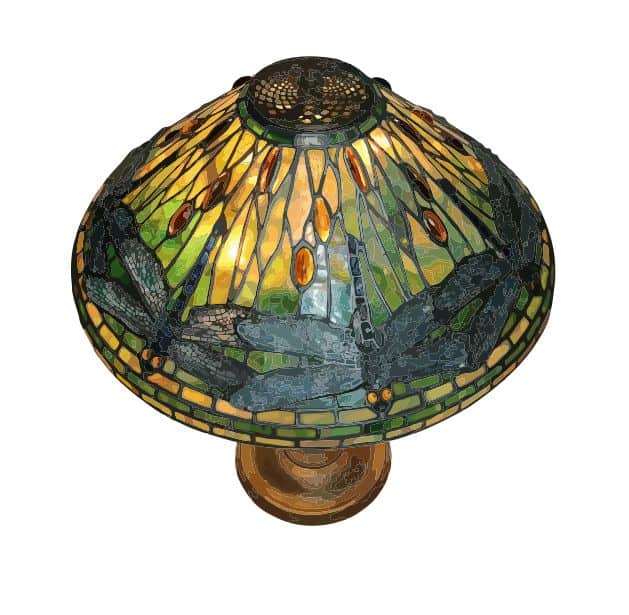
The main lampshade artist is now known to have been Clara Driscoll who was paid $10,000 per year in the early 1900s – making her the best-paid woman in the US. Among her classic designs is the famous Wisteria Lampshade which was priced in the Tiffany catalog at about $350.00 but sold for more than $1.5 million in 2005.
The current world record price was paid for the very rare “Pond Lily” lamp (right/below) of which only 16 examples are known.
Following the closing of the Tiffany glass factory in the 1930s, there was a hiatus in copper-foil lampshade production until the 1980s and 1990s when reproduction shades of varying quality started being made in countries with low labor costs – primarily Mexico and China.
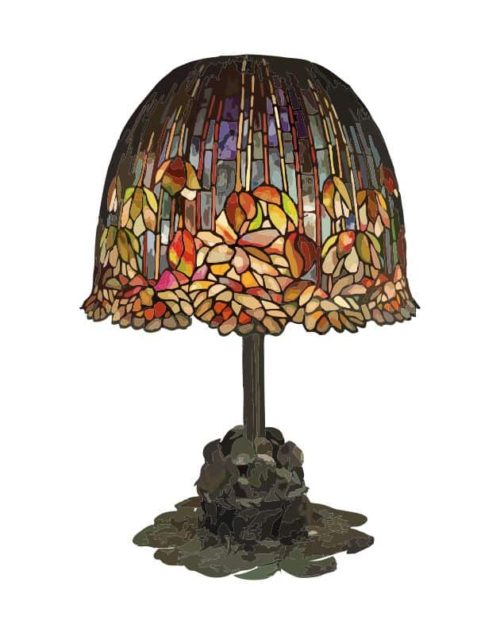
Repair & Restoration of Tiffany-style Lampshades
Defective heat-cap
Probably the commonest repair that we see at Artistry in Glass is due to inadequate soldering of the heat-cap or crown of the lampshade. The entire weight of the heavy shade is supported by the joint between the metal heat-cap and the stained glass and this joint often fails on reproduction Tiffany shades.

Reinforcement of Heat-Cap
The recommended restoration method for safely securing the heat-cap is to join the cap to the body of the lamp with soldered copper wire. In this way, the large weight of the art glass is distributed along four strong attachment points.
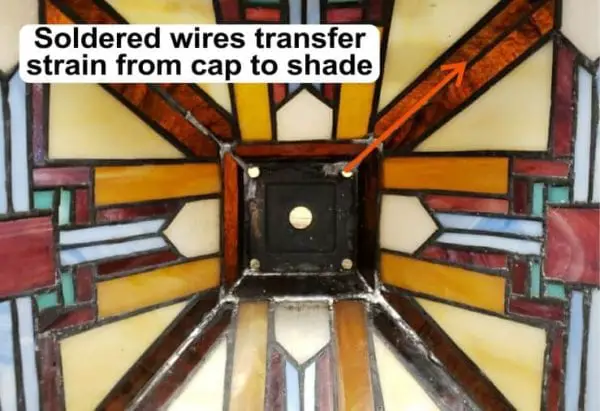

Use LED lights
Failure of the heat-cap is accelerated by the use of old-fashioned incandescent light bulbs. The heat generated by these bulbs causes expansion and contraction of the solder joints promoting detachment. Change to LED to avoid heat build-up (and save dollars!)
Repair of Tiffany Glass Lampshades
If the heat-cap fails or your lampshade is damaged in moving – carefully bring it into Artistry in Glass for an expert repair appraisal. The cost will depend on the extent of the damage and the type of shade. Original Tiffany lampshades require especial care as explained below
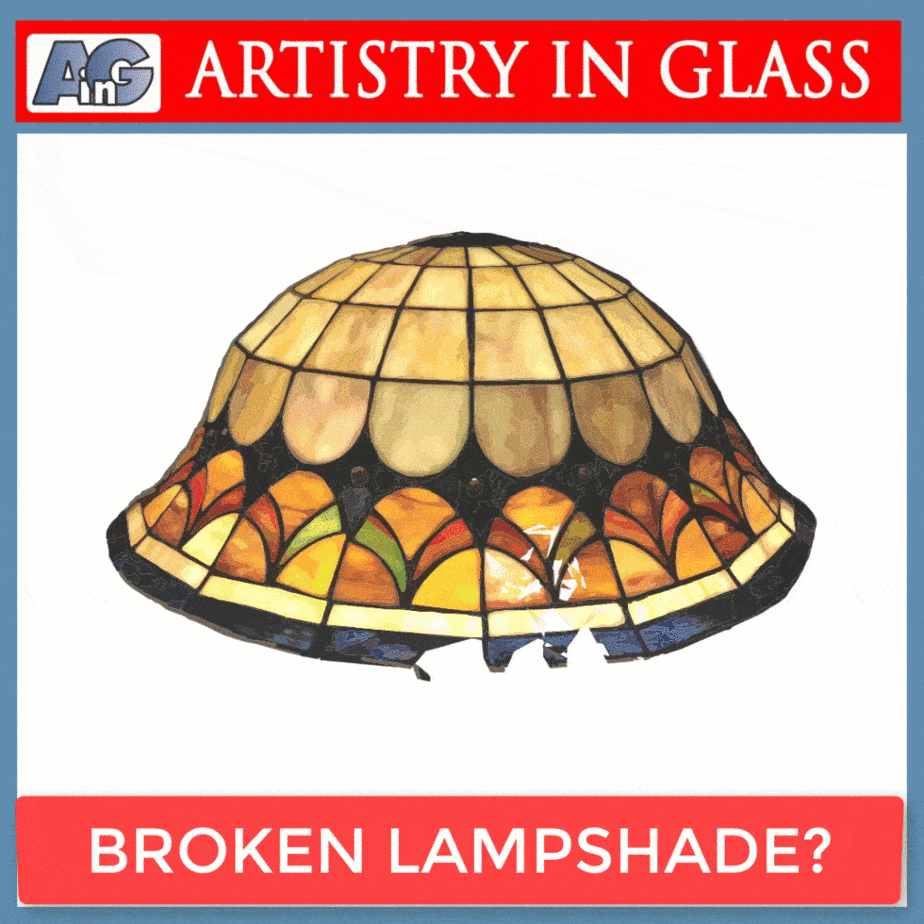
Replacement Tiffany Lampshades
The restoration of Tiffany-style lampshades is very labor-intensive and the cost is sometimes more than the lamp is worth. in this case, and especially if the shade is not of sentimental value it is best to look for a replacement.
WeiJuMei Tiffany Style Square Lamp Shade is available through Amazon and is 13 3/ 4″ across and about 6 1/2″ tall with a diagonal length of 19 3/8.
Premium Tiffany-style Orange Butterfly replacement lampshade – 12″ diameter by 4 3/8″ tall. Exquisite textured glass in copper foil – available through Amazon.
Repair of Genuine Tiffany Lampshades
Genuine Tiffany lampshades need a special level of consideration and competence because of their rarity and extremely high value.
The main challenge with damaged Tiffany lampshades is finding glass to match the original glass. At Artistry in Glass, we have an archive of antique art glass that allows us to match many antique lamps but, if necessary, we can use our hot kiln expertise to create new glass by fusing. Sometimes it is preferable to carefully glue cracked panels in order to preserve the original glass. Our optically clear UV-activated adhesive can make the join almost invisible.
The overwhelming imperative is to maintain the original appearance and we do so by duplicating the solder-lines and patina. If the lamp does not work, rewiring is permissible but every attempt is made to preserve the original bulb-holder and metal fixtures. Contact Artistry in Glass for the repair of both shades and electrical rewiring.
Artistry in Glass got the job done …
“We searched several businesses to find someone who was capable of restoring a badly damaged, expensive, tiffany-style, glass lamp shade. Artistry in Glass got the job done …. beautifully, affordably and on time.”
Rick Rupkey, Sr., Tucson, AZ
2) Leaded-glass Lampshades
Simple lampshades – stained (colored) glass in lead, zinc or brass frames
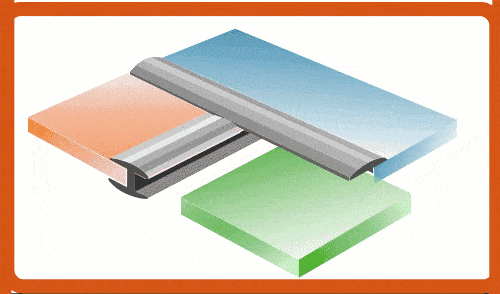
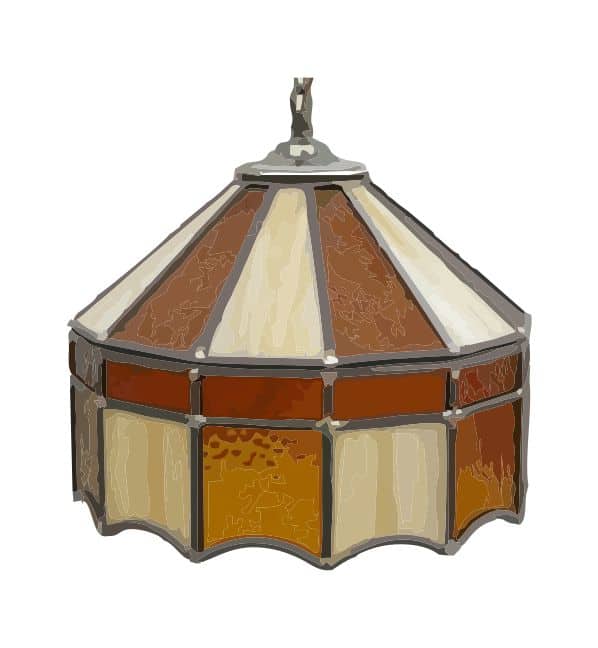
As a reaction to the exuberance and complexity of the Art Nouveau period, the Arts and Crafts movement promoted a purity of design where the attraction of colored art glass could still be enjoyed, but in a simple geometric framework. At the same time, the rising costs of labor made rectilinear designs much more affordable to construct. Lampshades like those shown here reflected the mid-century esthetic as well as being simpler for hobbyists to manufacture.
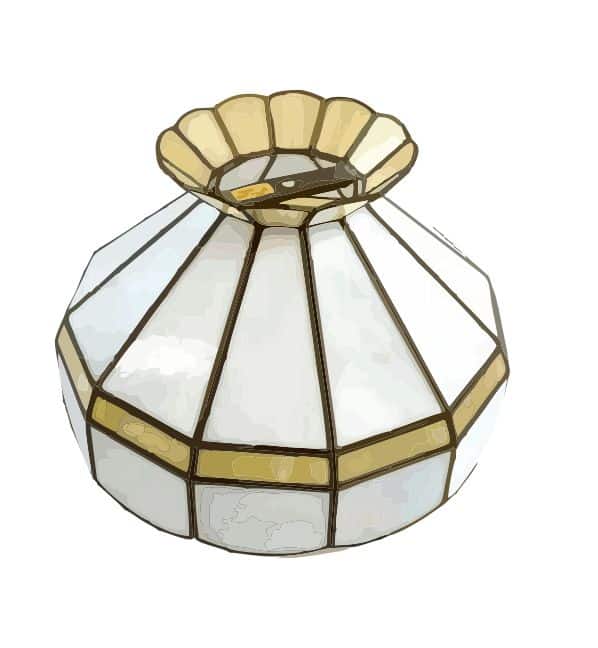
Repair of Leaded Glass Lampshades
Simple leaded glass lampshades are not inherently valuable or even attractive except in an Arts & Crafts setting, but they are well worth repairing if there is a sentimental attachment and especially if the shade was made by a family member.
Matching Glass – Color and Translucency
At Artistry in Glass, we have been matching stained glass colors for more than 30 years and have a large inventory of stained glass in our workshop. The key is to select the correct color in both reflected and transmitted light and for the best shade result the glass must be semi-obscure or opalescent so that light can shine through but the lamp will not reveal “hot-spots” (the detail of the light bulb). A common weak point – the joint between the heat-cap and the heavy glass shade, is also reinforced during our restoration work.
Delightful people …
“Excellent, fast service. Soldering repairs were made to my antique chandelier as well as adding matching stained glass. Reasonably priced. Delightful people to deal with.”
Helen Landerman, Tucson AZ.
3) Slag Glass Lampshades
What is Slag Glass?
Slag glass is a type of opalescent, semi-opaque, art glass with a streaky or mottled texture. It was first made late-19th-century England, where the manufacturers added slag from iron-works to molten glass in order to produce textural patterns like tortoiseshell and marbling. Because of its light-transmitting properties, slag glass became widely used in lampshades. The most common colors for original slag glass were golden amber/orange, turquoise & malachite green and purple. Slag glass has, rather confusingly, given its name to the range of lamps and lampshades in which it is incorporated into cast metal frames. The lamp frames and bases are made from “white” or “pot” – metal which is cast into a variety of ornate, filigree styles from art nouveau to arts and crafts.
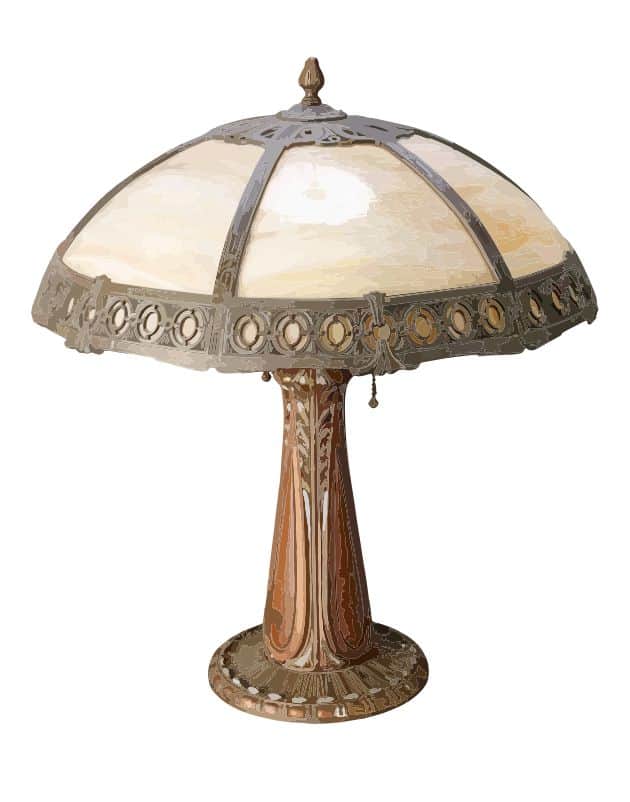
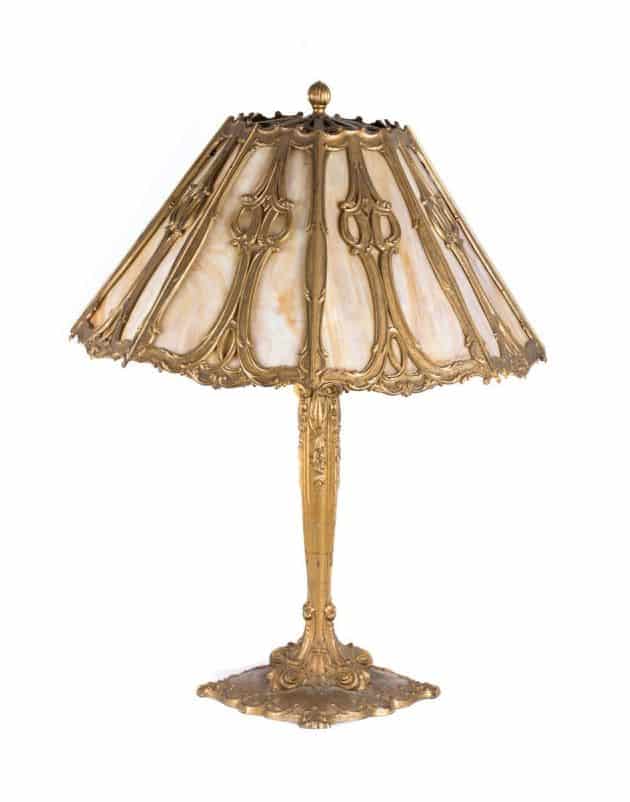
Manufacturers and Value of Slag Lamps
The prominent US manufacturers of Slag Glass lamps were Bradley & Hubbard, Challinor, Taylor, and Co, Westmoreland, Miller Co., and Akro Agate. The original low retail prices ($5.00 – $20.00) made them an affordable alternative to much more expensive Tiffany lamps. Slag lamps rarely carry a logo or trademark so collecters should consult qualified antique appraisers for verification. Good examples of Slag Glass lamps can realize prices in the $500.00 to $1500.00 range or more in today’s market.
Repair of Slag Glass Lamps
The common repair issues that we encounter at Artistry in Glass are:-
- Damage to the metal frame
- Cracked or missing slag glass
Repair of Slag Glass Frames
The material of the frames is generally pot metal (originally named for the practice in metal foundries of melting various left-over metals (zinc, copper, tin, iron) to make low-temperature alloys). Pot metal is easily cast because of its low melting point but is brittle and easily broken. The repair involves a combination of careful soldering and use of special epoxies combined with the application of paint and patina to disguise the new joins. An additional metal repair is sometimes necessary to the copper or brass tabs which are bent underneath the shade to secure the curved glass.
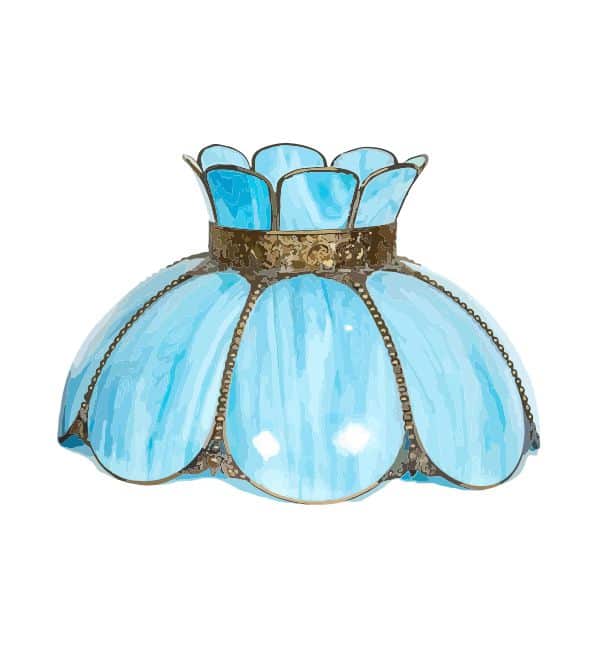
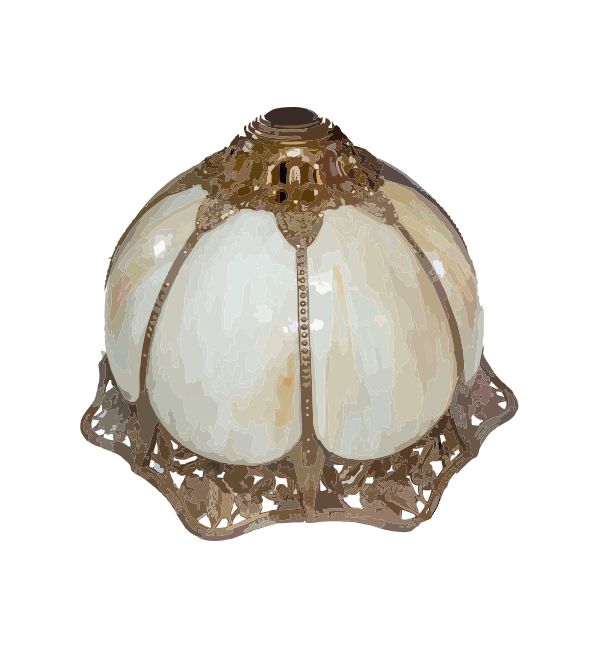
Repair of Slag Glass Panels
Two problems have to be solved in order to replace a missing or badly broken slag glass pattern:-
- Matching the original art glass
- Re-creating the curved shape of the original glass
Matching the Original Glass
As with Tiffany-style lampshade repairs, the crucial first step is to match the original glass. It is important to note that the replacement glass must match in both transmitted and reflected light. A problem that has arisen recently is that several US glass factories have closed so that slag-type glass is more difficult to obtain. For this reason, it is sometimes necessary to recommend gluing a broken panel to preserve the original glass. The second option is to use the closest match and suggest turning the replacement side to the back when displayed. A final and much more expensive option is to remake all the panels.
Customers must understand a paradigm of the antique business which is that once an item is broken it has lost a considerable amount of its original value – so the repair process is a way to restore broken memories rather than a way to restore the original value.
Matching the Curved Shape
The second (and sometimes tricky) part of the slag glass replacement process is to recreate the exact shape of the glass. If the broken panel is planar (flat) then the problem of cutting the glass is simple. Unfortunately, most panels are curved – into either single curves, double curves or even triple curves.
Making a Mold
With curved glass, the time-consuming and therefore expensive part of the repair is making a mold. We need an example of an unbroken panel, from which we construct a custom plaster mold. Then the new art glass (slag glass) is placed on the mold and heated in the kiln until it becomes soft and slumps down to form the correct shape.
The cost of reproducing slumped glass depends on the exact details but prices for simple shapes are about $100 for the initial panel and $55 for each additional panel. For double and triple curved panels our prices are about $125 for the first panel, $65 for each additional panel.
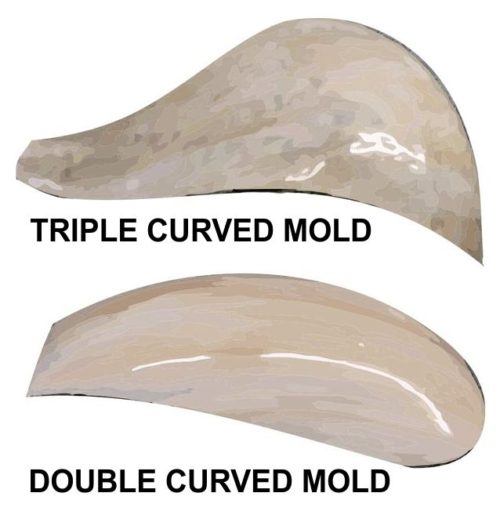
4) Beveled Glass Lampshades & Fixtures
Pendant Lamps for America
Starting in the 1980s and 1990s, lamp companies started making pendant lamps with brass or chrome frames and including sparkling beveled edged glass panels. The lamps took the place of more elaborate and baroque crystal chandeliers and are designed to be hung in residential hall or entryways or as lights to illuminate dining tables. Since the turn of the century, manufacturing has largely shifted to China.
Damage normally only occurs when these lamps are moved as owners re-locate to a new home. If a beveled glass panel is broken it is never possible to order a new replacement from the manufacturer. At Artistry in Glass, we can custom-bevel glass or, suggest the more economical alternative of substituting plain (not beveled) glass (the difference hardly shows).
Make sure you pack these lamps carefully when moving house – the moving men specialize in busting these lamps!
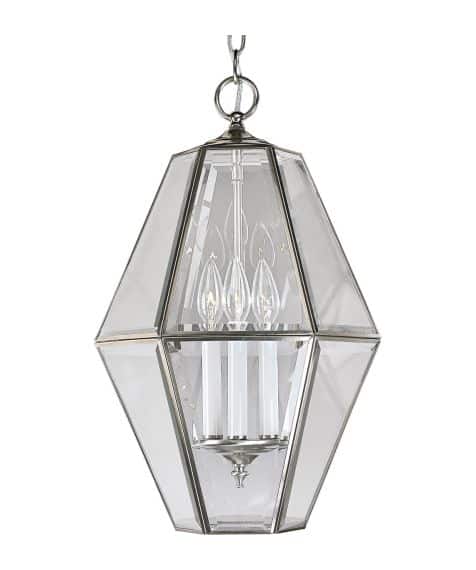
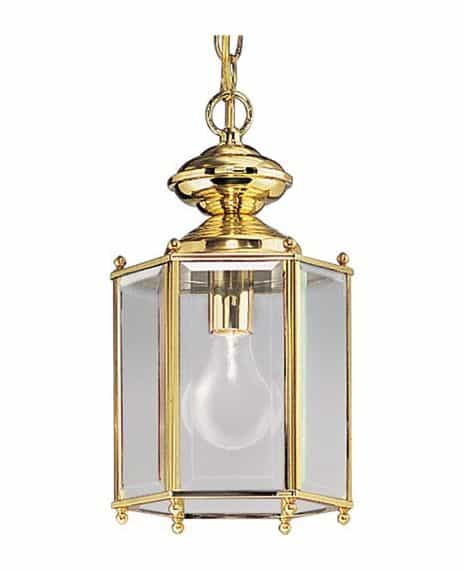

5) Porch Lanterns & Lampshades
Homeowners, commercial businesses and renters come to Artistry in Glass on a weekly basis to replace broken or vandalized lantern panels. We have a large selection of art glass and can match most missing parts.
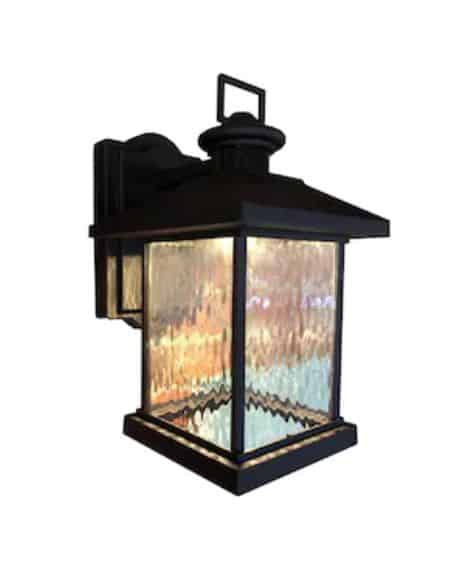
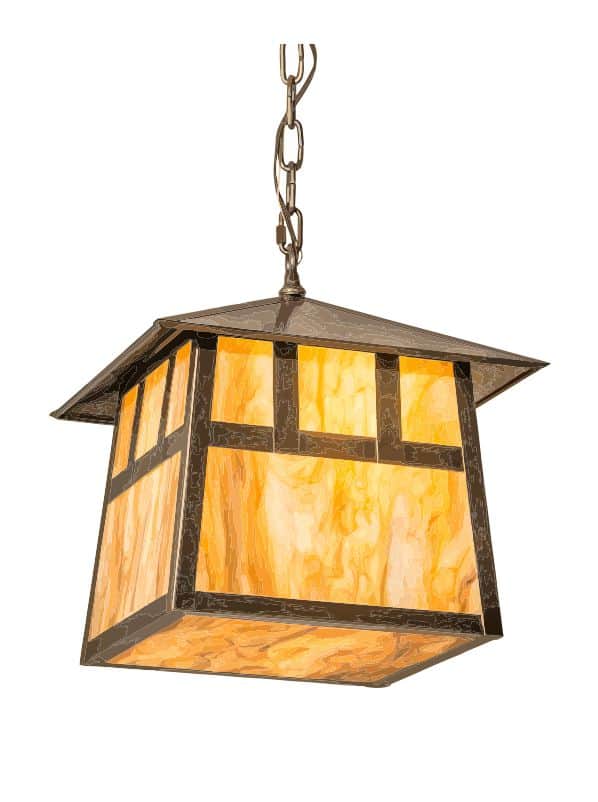
Simple repair consists of matching the gold/amber streaky glass.
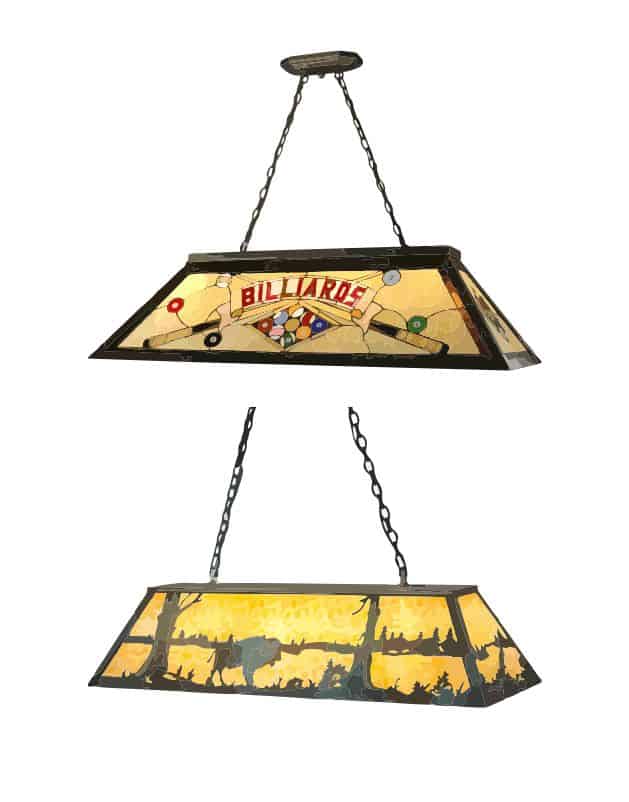
6) Opal, Ball or Dome Glass Shades
Opal glass lampshades were originally developed for gas lights and, to a lesser extent, kerosene lamps in the Victorian era. Prized examples were hand-painted and fired in the kiln, generally with floral motifs.
In rare cases when a specific design has to be duplicated, Artistry in Glass can hand-paint a plain opal shade to match the original. Otherwise, there are a large number of sources for reproduction shades. Follow this link (and specify the diameter of the shade opening (often 3 1/2″ or 4″) in order to order the correct size.
With cylindrical shades, Artistry in Glass can cut down the glass to create a shade of the correct height.
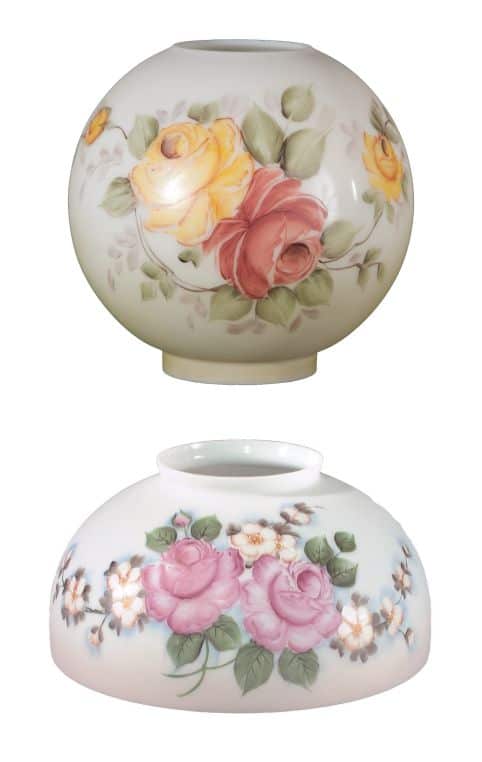
Trust Artistry in Glass to Restore your Treasured Art Glass Lamp
It is truly a joy to me …
“I’m finally back in Santa Fe after some time in Europe. I unpacked the porcelain lamp you repaired for me and am enjoying it every day. It is truly a joy to me, the last heirloom I have from my mother. Thank you for your good work and safe shipment. Thank you! And may you continue to prosper. Blessings,”
Diana Thatcher, Santa Fe, NM
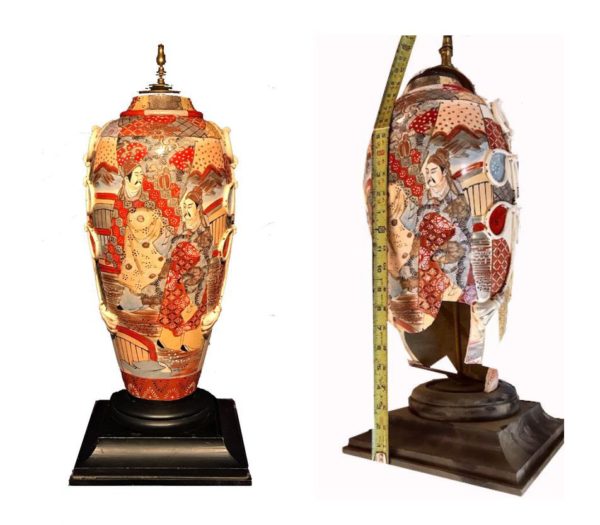
Call the Art Glass Lamp expert at Artistry in Glass 520-320-0104
Or, better still, just bring your lamp into our mid-town showroom for a free repair estimate
All you need to know about art glass
Commissioning stained and etched glass
- Stained glass designs from Artistry in Glass
- How to commission a stained glass window – complete advice
- How to commission an etched glass window
- How to choose the best stained glass design
- Etched or stained glass – which is better for your home?
- How much does stained glass cost?
- How much does etched glass cost?
Technical information
- Is leaded glass dangerous? Learn the facts.
- How to replace broken patio table glass
- Plexiglass and glass – what are the pros and cons?
- What is plexiglass used for?
- What costs more – glass or plexiglass?
- Preservation of stained glass in churches & synagogues
- How does stained glass get colored? learn from an expert!
- Is your broken stained glass panel worth repairing?
- How to protect stained glass in religious buildings
- How to care for and clean stained glass
- How to repair cracked stained glass
- What is Dalle de Verre?
- How to repair Dalle de Verre
- What to do about bowed & sagging stained glass
- How to care for a stained glass skylight
- Can my stained glass lampshade be repaired?
- What is the difference between sandblasting & etching?
- Obscure and frosted glass – all you need to know!
- How to save money when buying glass
- Glossary of important terms used in decorative glass
- 14 Ways to sell stained glass
- What is imitation or faux stained glass?
Guides to stained glass design
- Guide for designing abstract stained glass
- Why choose abstract contemporary stained glass
- How to design a Frank Lloyd Wright-style window
- Designing a WWII-era stained glass Waco glider
- Stained glass and Black Lives Matter
- How Is stained glass used today?
Artistry in Glass was your source for antique repair in Tucson
Check out this amazing selection of informative articles:-
- Where can I get antiques repaired?
- Are broken antiques worth fixing?
- How to fix a broken picture frame
- How to repair a broken china plate
- How to repair a broken china teapot
- How to fix a broken marble slab
- How to repair a broken china coffee mug
- How to repair a 2000-year-old sculpture
- All about repairing stained-glass lampshades
- How to care for your stained glass skylight
- How to repair Dalle de Verre
- Is stained glass worth repairing?
- To repair or toss out?
- Tucson crystal & china repair a division of Artistry in Glass
- What to do with broken antiques
- Is lead crystal dangerous?
- Repairing an antique Mexican statue
- Repairing religious statues
- The history of Swarovski crystal figurines
- How to find the value of a Swarovski Crystal figurine
- Have Swarovski crystal figurines lost value since 2009?
- How to collect Swarovski annual ornaments
- How to display Swarovski crystal figurines
- How to authenticate a Swarovski crystal figurine
- How to display Swarovski annual ornaments
- How to clean Swarovski crystal figurines
- How to repair a Swarovski crystal mouse
- How to repair a Swarovski annual ornament
- How to repair a Swarovski crystal train set
- Fixing broken wine glass stems
- How to clean cloudy glasses
- Why do wine glasses have stems?
- Swarovski Crystal Figurines
- How to repair a chip in a wine glass
- How to fix a scratched glass tabletop
- How to replace a broken patio tabletop
We are a participant in the Amazon Services LLC Associates Program, an affiliate advertising program designed to provide a means for us to earn fees by linking to Amazon.com and affiliated sites.

